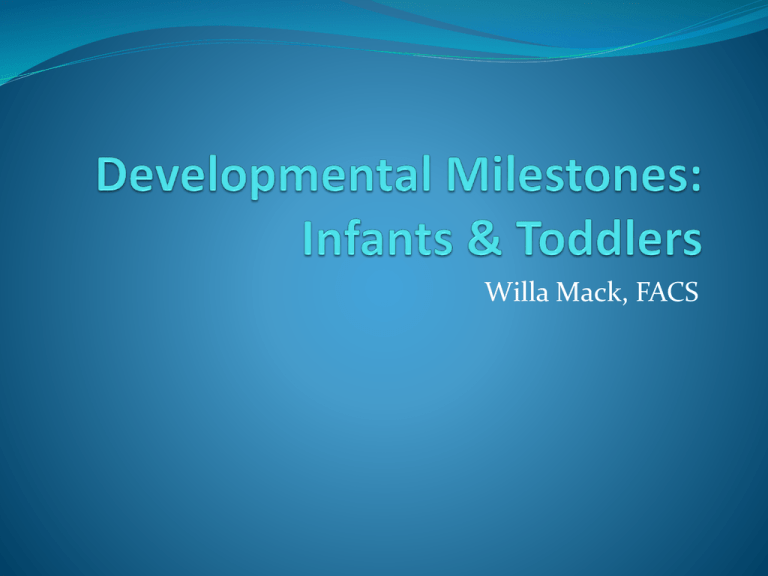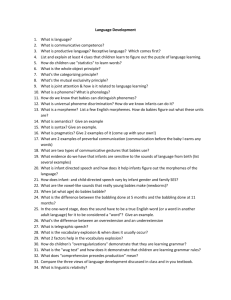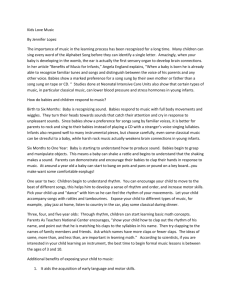Developmental Milestones: Infants & Toddlers
advertisement

Willa Mack, FACS Physical Development: Infants BIRTH TO SIX MONTHS - At birth, infants cannot control their body movements. Most of their movements are reflexes. Their nervous system is not fully developed. - For the first few months, infants can see clearly objects that are about 10 inches away from their faces. By 6 months, their vision is more fully developed. - By 4 months, most babies have some control of their muscles and nervous system. They can sit with support, hold their head up for short periods of time, and can roll from their side to their stomach. - By 5 months, most babies can roll over. Physical Development: Infants SIX TO TWELVE MONTHS - Infants can sit alone. - They start to eat and sleep at regular times. - By 8 months, they can reach for and hold objects. - They eat three meals a day and drink from bottles at various times. - They start using a cup and spoon to feed themselves. - Infants still take a nap in the morning and in the afternoon. - They crawl with their stomach touching the floor, and they creep on their hands and knees. - They pull up to stand, they stand holding onto furniture, and they can walk when led. - They can pick up objects with their thumb and forefinger and let objects go (drops things). They start to throw things. - By the time they are 12 months old, most babies weigh three times what they weighed at birth and are two times as long as they were at birth. Social & Emotional Development: Infants BIRTH TO SIX MONTHS - They begin to develop trust as their parents and providers meet their needs (for example, feeding them when they are hungry, changing their diapers when needed, or holding them when they cry). - When frightened, infants cry and look surprised and afraid. They cry to express hunger, anger, and pain. It is their way of communicating. - They are easily excited or upset. - They need to be cradled and comforted. - It seems as if they cannot tell where their bodies end and someone else's begins. - Infants smile in response to a pleasant sound or a full stomach. At about 6 weeks, they smile in response to someone else. By 4 months, they smile broadly and laugh when pleased. - They learn to recognize faces and voices of parents and providers. Social & Emotional Development: Infants SIX TO TWELVE MONTHS - Infants will talk to themselves in front of a mirror. - They respond when you say their names. - They get angry and frustrated when their needs (for example, being fed, having diapers changed, being held) are not met in a reasonable amount of time. - Eye contact begins to replace some of the physical contact that younger infants seek. - They begin to learn what is and is not allowed. - They begin to fear strangers. They begin to fear being left by their parents or other care providers. Intellectual Development: Infants BIRTH TO SIX MONTHS - Infants can focus on and follow moving objects with their eyes. - They cry in different ways to express hunger, anger, and pain. - They babble, coo, and gurgle. - They turn to locate the source of sounds. - They study their hands and feet. - They forget about objects that they cannot see. - They explore things with their mouth. They put anything they can hold into their mouth. Intellectual Development: Infants SIX TO TWELVE MONTHS - Infants make sounds like "dada" and "mama" (two-syllable sounds). - They repeat actions that cause a response. (For example, when given a rattle, they will shake it and laugh.) - They wave bye-bye and play pat-a-cake. - They look for things not in sight. - They begin to pretend by acting out familiar activities. - They respond to simple directions. - They make sounds that can be understood by people who know them well. - By 12 months, many infants speak their first understandable words. Activities to Try BIRTH TO SIX MONTHS - Talk and sing to the babies when you feed, diaper, and clean them. - Imitate the sounds that the babies make. - Point to and say the names of the babies' mouth, ears, nose, fingers, etc. - Place toys and other colorful objects where babies can see and/or touch them. - Shake a rattle behind a baby's head and let the baby turn and grab the rattle. - When you hold or rock the baby, sing lullabies or other soothing songs. - Place babies in different positions. For example, place them on their stomach so they can practice lifting their head and rolling over. Encourage hand clasping and kicking. - Take care of babies' needs promptly. (For example, feed a hungry baby or comfort a scared baby.) Activities to Try SIX TO TWELVE MONTHS - Play peek-a-boo or other games in which you disappear and reappear. - Give babies a safe place where they can crawl, creep, and pull themselves up. - Roll a ball or place a toy where babies have to reach or crawl for it. - Give babies toys that squeak. - Give babies teething toys. - Read aloud books that have large pictures and not much writing. - Talk to babies and name objects as you and the babies handle them. - Begin to teach what is allowed and what is not allowed. - Do not force baby to interact with strangers. - When babies indicate that they want help, provide it. - Rock and hold babies when they are upset. - Let babies fill containers with objects and then dump them out. - Change toys often when babies get bored with them. Things to Remember Babies learn trust and that they are loved when you respond to their needs for food, comfort, and attention. Toys that go in babies' mouths should be cleaned before giving them to another child. Toys should be big enough so that infants cannot swallow them. Games and toys are the tools that infants use to learn. Unless the parents are harsh or critical, the way you and the parents treat the infants should be similar. Taking care of infants is demanding work. When the infants are not in your home, take some time to do something for yourself Physical Development: Toddlers One year olds They may grow less quickly than during infancy. They may eat less, but they tend to eat frequently throughout the day. Most walk without support by 14 months. Most walk backward and up steps by 22 months. They get better at feeding themselves, although spills should still be expected. They drink from a cup with help. They can stack blocks. They can scribble. Physical Development: Toddlers Two year olds Children are generally more active than at any other point in their lives. They walk, run, climb, walk up and down stairs alone, and dig. They throw balls and kick them forward. They jump with two feet together. They stand on tip toes. They take things apart and put them back together. They like to screw and unscrew lids. They feel discomfort with wet or soiled diapers. They start to show an interest in toilet training. SOCIAL AND EMOTIONAL DEVELOPMENT ONE-YEAR-OLD CHILDREN They want to do things independently. Temper tantrums are common. They enjoy playing by themselves or beside (not with) other children. They have difficulty sharing toys. They may be possessive. They cannot remember rules. They view themselves as the center of the world. They become increasingly more self-aware. They begin to express new emotions such as jealousy, affection, pride, and shame. They show increasing fears. They may continuously ask for their parents. They have rapid mood shifts. Their emotions are usually very intense but short-lived. Routines are very important. SOCIAL AND EMOTIONAL DEVELOPMENT TWO-YEAR-OLD CHILDREN They begin to play simple pretend games. Their fantasy play is very short and simple. It does not involve others. They are generally very self-centered and sharing is still difficult. They enjoy playing near other children. They try to assert themselves by saying "no." They sometimes do the opposite of what is asked. They like to imitate the behavior of adults and others. They want to help with household tasks. They become frustrated easily. They refuse help. They still need security. They are more sure of themselves than one-year-old children. INTELLECTUAL DEVELOPMENT ONE-YEAR-OLD CHILDREN They point to objects that they want. They are curious. They are curious. They imitate animal sounds. They name familiar people and objects. They combine two words to form a basic sentence. They use the pronouns me and mine. They use "no" frequently. They name body parts and familiar pictures. They use objects for their intended purpose. They begin to include a second person in pretend play. Their attention span is short. They can hold a pencil and scribble. They are very active. Because of their developing imagination, they have trouble knowing what is real and what is pretend. INTELLECTUAL DEVELOPMENT TWO-YEAR-OLD CHILDREN They follow simple directions. They use three or more words in combination. They express their feelings and wishes. They use objects to represent other objects. They still have a very limited attention span. They can memorize short rhymes. They join in simple songs. They begin to think about doing something before doing it. They have trouble making choices, but they want to make choices. ACTIVITIES TO TRY 1. Take some time to watch your toddlers playing. Notice the differences in their physical development: height, weight, how they relate to you and to other children, and their energy levels. Some children seem to never sit still, while others seem happy to sit down with a book. 2. Toddlers learn by exploring and experimenting. They love to do things over and over. Some activities that toddlers enjoy are listed below. ACTIVITIES TO TRY ONE-YEAR-OLD CHILDREN Roll a ball to them to catch. Provide blocks for them to build with. Provide safe mirrors for them to look at themselves in. Talk with them about their reflections in the mirror. Let them fill containers over and over again. Have them listen and move to music. Play hide and seek. Let them push or pull a favorite toy. Provide wheeled toys without pedals. Look at picture books with them and talk about the pictures. Talk about the size, shape, and texture of everyday objects. Make comparisons such as "this ball is bigger than that ball." Talk about cause-and-effect relationships such as "if you push this block, the whole pile of blocks will fall over." ACTIVITIES TO TRY TWO-YEAR-OLD CHILDREN Encourage toddlers to run, jump, and climb outside. Sing simple songs with them. Sing and act out songs with simple movements. Play pat-a-cake. Teach them simple finger plays. Tell them simple, short stories (especially those about themselves or other two-year-old children). Let them pound a toy workbench. Let them play in a sandbox. Give them water to measure and pour. Let them stack blocks and other objects. Provide things that can be taken apart and put back together (such as pop beads). Ask children to name things in the pictures of picture books. Give them the correct word if they cannot think of it. Give them simple directions to follow. Play matching games and use simple puzzles with them. Encourage pretending by providing dolls, housekeeping toys, dress-up clothes, and toy telephones. Introduce art activities such as scribbling and/or painting with crayons, chalk, and paint. Provide play dough and finger paint. Begin toilet training when the toddler is ready. Also, begin teaching hand washing and tooth brushing. Encourage the development of routines.







